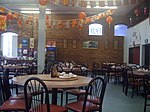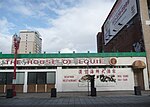Festival Lanterns
2006 establishments in Oregon2006 sculpturesGranite sculptures in OregonJapanese-American culture in Portland, OregonNorthwest Portland, Oregon ... and 4 more
Old Town ChinatownOregon sculpture stubsOutdoor sculptures in Portland, OregonSteel sculptures in Oregon
Festival Lanterns is an outdoor 2006 art installation consisting of granite and steel sculptures by American artist Brian Goldbloom, installed in northwest Portland, Oregon, in the United States. The work is administered by the Regional Arts & Culture Council.
Excerpt from the Wikipedia article Festival Lanterns (License: CC BY-SA 3.0, Authors).Festival Lanterns
Northwest 5th Avenue, Portland Old Town
Geographical coordinates (GPS) Address Nearby Places Show on map
Geographical coordinates (GPS)
| Latitude | Longitude |
|---|---|
| N 45.526 ° | E -122.67366666667 ° |
Address
Portland New Chinatown-Japantown Historic District
Northwest 5th Avenue
97240 Portland, Old Town
Oregon, United States
Open on Google Maps







